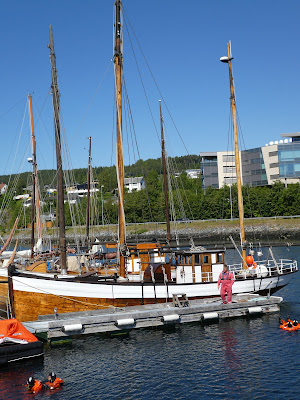Alesund was awarded the title "Norway's most beautiful city" by fellow Norwegians in 2007.
It is said that the town of Aalesund looks like it has stepped straight from a fairy tale.
Once on the bus, we head up Mt. Askla for a overview of the area. On the way our guide explains a little about the history of the area.
The cod and salmon fishing brought settlers here about 9,000 years ago. Over the following years it grew to be a very successful trading center for dried and salted codfish known as klippfisk around the world.
In 1904 a catastrophic fire swept through Alesund and destroyed 800 houses. It was then completely rebuilt between 1904 and 1907 in the Art Nouveau style that was very popular at the time.
Once on top of Mt. Askla, we have magnificent views of the city and the surrounding Sunnmore Alps, overlooking the five islands making up the scenic town.
Here's the postcard view of the colorful buildings. There is a canal or waterway in the middle of the town called Brosundet, or "Bridge sound. The name Ale sund (sloping sound), means that the sound slopes through town. This is how Alesund got its name.
Our next stop was at the Sunnmore Museum, an open-air museum made up of 55 old and distinct houses, some dating from the 17th century. Most Norwegians lived a hard life, often were very poor and lived from agriculture and fishing.
We started out in the boathouse, where we saw the boats used for fishing.
Our guide walks with us briefly to explain the buildings. This building was the shoemaker.
The shoemakers were the only shops that remained open during the WWII Nazi occupation. Guess those soldier boots needed repairing.
This was once the schoolhouse. It's a 2-story building as the teacher lived above the classroom.
This vessel was a fishing boat but also played an important role in WWII by transporting Norwegian resistance fighters between Norway and England.
We then traveled to the island of Giske via tunnels under the fjords. Giske is known as the birthplace of the famous Viking Rollo, who was the first Duke of Normandy and an ancestor of the British Royal Family. Ha ha! This is how Norwegian blood got into Great Britain!
We did a photo stop at the marble church, built in the 12th century of marble imported from Italy or Portugal.
At some point the church was painted white. A small section was left unpainted to show the original marble.Our next stop on the tour was at the old harbor in Alesund. We visited the Fisheries Museum in an old seahouse.
Exhibits in the museum show how the seahouse has been used for fish processing and medicinal oils throughout the years.
The laboratory...
...and the medicinal cod liver oil
We walked along Molja, Norway's oldest pier and lighthouse dating back to 1858.
Back on the bus we headed to one more viewpoint across the fjord from where the port is located. There's Mt. Askla on the right behind the Princess ship.
That evening it was time to sail away. We have only one more port in Norway, Bergen; we arrive there after one more sea day.
July 4 at Alesund: Sunrise, 3:49 am; Sunset 10:28 pm
To continue reading, scroll down and click on Newer Post.






























No comments:
Post a Comment